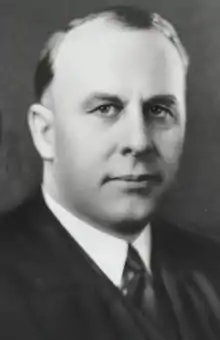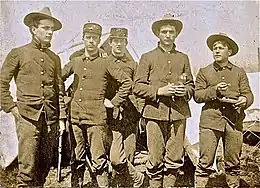John W. Shenk
John Wesley Shenk (February 7, 1875 – August 3, 1959) was a city attorney in Los Angeles, California, a Superior Court judge and a member of the California Supreme Court.
John Wesley Shenk | |
|---|---|
 John Wesley Shenk | |
| Associate Justice of the California Supreme Court | |
| In office April 14, 1924 – August 3, 1959 | |
| Appointed by | Governor Friend W. Richardson |
| Preceded by | Louis W. Myers |
| Succeeded by | Thomas P. White |
| Los Angeles City Attorney | |
| In office 1910–1913 | |
| Appointed by | Direct election |
| Preceded by | Leslie R. Hewitt |
| Succeeded by | Albert Lee Stephens Sr. |
| Personal details | |
| Born | February 7, 1875 Shelburne, Vermont |
| Died | August 3, 1959 (aged 84) Los Altos, California |
| Spouse(s) | Lena R. Custer (m. 1907) |
| Alma mater | Ohio Wesleyan University (BA) University of Michigan School of Law (LLB) |
Early life and education
Shenk was born on February 7, 1875, in Shelburne, Vermont, the son of John Wesley Shenk of Cobbleskill, New York, who was a Methodist minister (died July 1922), and Susannah C. Brooks (died April 1929). He had three brothers, William W., Edmund S. and Adolphus B., and two sisters, Carrie M. (Wilson) and Susannah C. (McRae).[1] He was educated in Shelbourne and in Omaha, Nebraska, public schools and received a Bachelor of Arts degree from Ohio Wesleyan University and a law degree from the University of Michigan School of Law in 1903, after which he passed an oral examination for the bar before the California Supreme Court. He later received honorary doctor of laws degrees from both universities and from the University of Southern California.[2][3][4]
Career
Non-legal

In Shenk's youth, he was a printer, farmer, painter and newspaper reporter. He was a soldier during the Spanish–American War when he was with the 4th Ohio Infantry, which saw service in Puerto Rico. After the war, he joined his brother Adolphus in the Imperial Valley as a farm hand and mule skinner, then, at the age of 26, as a school teacher.[3]
Los Angeles
In 1906 Shenk was appointed a deputy city attorney in Los Angeles, California, and in 1909 he became city attorney when Leslie R. Hewitt resigned from that position.[5][3] During his term, the cities of Wilmington and San Pedro, were merged with the city of Los Angeles, and Shenk later recalled "a midnight trip midst irate farmers and sharp-toothed watch dogs as he hurriedly listing polling places and secured names of election officers for the required ordinance calling the annexation election." Shenk was in charge of the city's legal office when Los Angeles annexed the San Fernando Valley and began the Owens River Project to bring water to the city through the Los Angeles Aqueduct.[3]
In a memorial tribute to Shenk written after his death, U.S. Judge Stanley N. Barnes recalled Shenk's role in a controversy between the city and the Pacific Electric Railroad, which wanted to lay a spur railroad track to some land in San Pedro to which it claimed ownership. Barnes said:
It was necessary to cross First Street in San Pedro. City Attorney Shenk said this required a franchise. By way of answer, and over the Labor Day weekend and holiday, the Pacific Electric hurriedly installed the track over the street—relying on the absence of judges and injunctions over the holidays and a fait accompli. The Board of Public Works, acting on the advice of John Shenk, paid back in kind on the following weekend. It took men, horses and equipment to the harbor, took possession of the empty railroad cars after removing them, tore up the tracks and announced the city was and would remain in possession. The Outer Harbor was saved for the people of Los Angeles.
Barnes added in regard to Shenk's influence: "Then there was the development of municipal power; the "Hyperion" sewer problem; the famous Griffith Park case ... the acquisition of the Los Angeles Public Library site; [and] the Water District Act of 1913—still known as the Shenk Act.[3]
The Shenk Decision
In 1912, the mayor asked Shenk to investigate an incident in which African American businessman C.W. Holden was charged a dollar for a beer at a saloon where white customers were charged only five cents for the same order.[6] Shenk's decision "that businesses had the right to charge whatever they desired and could change their prices at will,"[7] resulted in unprecedented discrimination against African Americans throughout the city. The effects of the Shenk Decision were chronicled in Los Angeles's African American newspapers, which included the California Eagle and the weekly newsmagazine, the Liberator[8][7] which asserted, "by a ruling as city attorney, Mr. Shenk completely nullified the Civil Rights bill in this state."[9]
The 1913 Mayoral Race
In 1913, Shenk ran for Mayor of Los Angeles as the candidate of the "good government" Municipal Conference. Based on Shenk's discriminatory decision the year before, African American newspapers urged their readers to vote against Shenk. Shenk lost to the independent candidate,[10] city Police Judge Henry R. Rose[11][12][13] by just over nine thousand votes[12] at a time when, according to the Liberator, African Americans represented fifteen thousand votes.[9]
In July 1913, after stepping down as City Attorney Shenk returned to private practice with E. R. Young, who had served as chief assistant City Attorney.[14]
In August 1913, Governor Hiram Johnson appointed Shenk to succeed Nathaniel P. Conrey as a judge in the Los Angeles Superior Court.[15] In November 1914, Shenk was elected to a full term on the court.[16][17]
Supreme Court
In 1924, Governor Friend W. Richardson named Shenk as an Associate Justice of the California Supreme Court, where he sat for 35 years and wrote 1,355 opinions.[3]
Two of his notable opinions are a 1945 decision for a unanimous court in Alfafara v. Fross that Filipino-Americans were not aliens under the definition of the California constitution and therefore were eligible to buy and sell property in the state.[18][19]
A second notable opinion is his 1948 dissent in the case of Perez v. Sharp, in which the court held by a vote of 4 to 3 that interracial bans on marriage violated the Fourteenth Amendment to the United States Constitution and therefore were illegal in California. The opinion was the first of any state to strike down an anti-miscegenation law in the United States.[20] In his dissent, joined by B. Rey Schauer and Homer R. Spence,[21] Shenk wrote:
The power of a state to regulate and control the basic social relationship of marriage of its domiciliaries is here challenged and set at nought by a majority order of this court arrived at not by a concurrence of reasons but by the end result of four votes supported by divergent concepts not supported by authority and in fact contrary to the decisions in this state and elsewhere. ... such laws have been in effect in this country since before our national independence and in this state since our first legislative session. They have never been declared unconstitutional by any court in the land although frequently they have been under attack. It is difficult to see why such laws, valid when enacted and constitutionally enforceable in this state for nearly 100 years and elsewhere for a much longer period of time, are now unconstitutional under the same Constitution and with no change in the factual situation. It will also be shown that they have a valid legislative purpose even though they may not conform to the sociogenetic views of some people. When that legislative purpose appears it is entirely beyond judicial power, properly exercised, to nullify them.[20]
Death
Shenk died on August 3, 1959, while still in office.[3]
Clubs
He was a Shriner and Knight Templar and a member of Lodge No. 99, Benevolent & Protective Order of Elks, Sons of the Revolution, Beta Theta Pi college fraternity and Phi Delta Phi legal fraternity, the Jonathan Club of Los Angeles and the Commonwealth Club of San Francisco. He was master of South Pasadena Masonic Lodge No. 367 and was a member of the Order of the Red Cross of Constantine.[2][3]
Personal life
On June 28, 1907, Shenk was married to Lena R. Custer in Los Angeles.[22] They had two sons, Samuel Custer and John Wesley Jr.[1] During the last 35 years of his life, he lived in Los Altos, California, where he was active in establishing a union church.
References
- "Last Rites Are Given to Minister", Los Angeles Times, July 6, 1922, p. 16. Retrieved September 21, 2017.
- H. James Boswell, American Blue Book California Lawyers (1928), page 25
- "In Memoriam," Cal. Reports 2d Vol. 53]
- "Mother of Jurist Passes to Reward,' Los Angeles Times, April 1, 1929, page A-8
- "John W. Shenk, Who Succeeds Hewitt as City Attorney". Los Angeles Herald. 37 (314). California Digital Newspaper Collection. 11 August 1910. p. 3. Retrieved September 21, 2017.
- Deverell, William; Sitton, Tom (1994-05-31). California Progressivism Revisited. University of California Press. ISBN 9780520084704.
- Heritage, Autry Museum of Western (2001). Seeking El Dorado: African Americans in California. University of Washington Press. p. 142. ISBN 9780295980829.
- Deverell, William; Sitton, Tom (1994-05-31). California Progressivism Revisited. University of California Press. p. 215. ISBN 9780520084704.
- Edmonds, Jefferson, ed. (April 4, 1913). "Shenk for Mayor? Wait!". The Liberator. 12 (1). Los Angeles, CA. p. 2. OCLC 12031126.
- Deverell, William; Sitton, Tom (1994-05-31). California Progressivism Revisited. University of California Press. p. 216. ISBN 9780520084704.
- "Early Vote Heavy; Shenk and Stevens Confident". Los Angeles Herald (186). California Digital Newspaper Collection. 6 May 1913. p. 2. Retrieved September 21, 2017.
- "Final Returns for Every Candidate". Los Angeles Herald (211). California Digital Newspaper Collection. 4 June 1913. p. 1. Retrieved September 21, 2017.
- "New City Attorney Quits His Civil Service Job". Los Angeles Herald (239). California Digital Newspaper Collection. 7 July 1913. p. 1. Retrieved September 21, 2017.
- "Former City Attorney Returns to Law Practice". Los Angeles Herald (240). 8 July 1913. p. 11. Retrieved September 21, 2017.
- "Six Los Angeles Judges Named by Governor Johnson". San Francisco Call. 114 (75). California Digital Newspaper Collection. 14 August 1913. p. 1. Retrieved September 21, 2017.
- "New Superior Judges List Issued by Jordan". Los Angeles Herald (23). California Digital Newspaper Collection. 27 November 1914. p. 3. Retrieved September 21, 2017.
- "Judge Shenk Returns". Los Angeles Herald (103). California Digital Newspaper Collection. 1 March 1920. p. A3. Retrieved September 21, 2017.
- Rodel Rodis, "Were Filipinos 'Aliens' in the United States?" Asian Week, July 31, 2013 Archived July 14, 2014, at the Wayback Machine
- Alfafara v. Fross. 26 Cal.2d 358 S. F. No. 17108. In Bank. May 22, 1945. Retrieved September 21, 2017.
- Perez v. Sharp (October 1, 1948), 32 Cal.2d 711, 198 P.2d 17. Retrieved September 21, 2017.
- Rose Cuison Villazor and Kevin Noble Maillard, Loving v. Virginia in a Post-Racial World: Rethinking Race, Sex, and Marriage (2012), p. 78. ISBN 0521147980.
- "Society: Shenk-Custer Wedding". Los Angeles Herald. California Digital Newspaper Collection. 30 June 1907. p. 2. Retrieved September 21, 2017.
External links
- John W. Shenk. California Supreme Court Historical Society.
- Guide to the John W. Shenk Papers, 1900-1935. Stanford University Libraries. Online Archive of California.
- John W. Shenk papers, 1930–1935. Worldcat.org.
- Past & Present Justices. California State Courts. Retrieved July 19, 2017.
See also
| Political offices | ||
|---|---|---|
| Preceded by Leslie R. Hewitt |
Los Angeles City Attorney John W. Shenk 1910 – 1913 |
Succeeded by Albert Lee Stephens Sr. |
| Preceded by Louis W. Myers |
Associate Justice of the California Supreme Court 1924 – 1959 |
Succeeded by Thomas P. White |